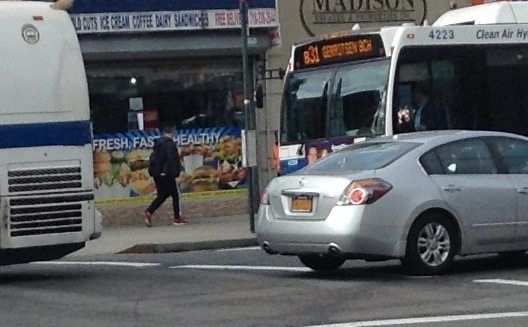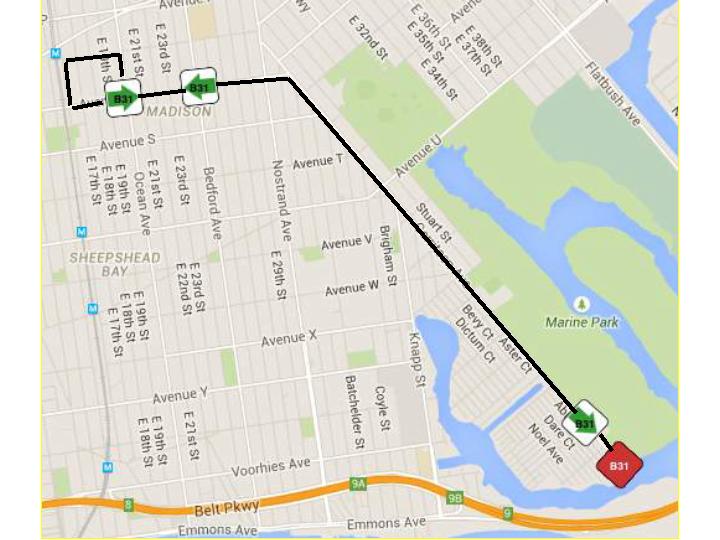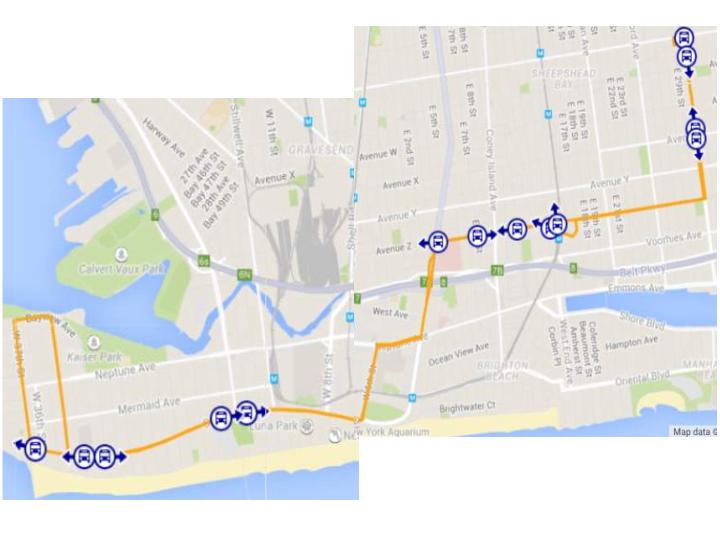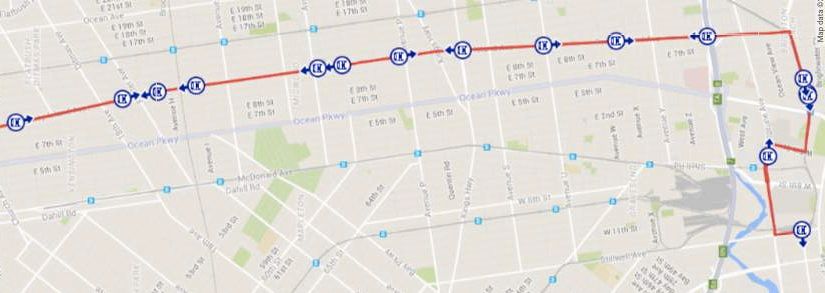The Commute: How Common Is Bus Bunching?


THE COMMUTE: Last Thursday, I had an appointment near the Kings Highway train station on the Brighton line. I either take the B1 or B49 to the train. At around 11am, three buses arrived, all three not in service. Shortly thereafter a B1 did not stop and only had about 15 passengers. Then I boarded a nearly empty B49. Who knows how much longer I would have had to wait if I had to take the B1? I have written many times about buses regularly bypassing passengers on this route. Returning home I decided to take the B68 to the B1. The B68 arrived right away, but no B1 for quite a while.
The situation is all too familiar: No route is immune to long delays. Generally, I find that buses work fairly well about a third of the time. While a third of the time there are minor delays, and a third of the time the delays are severe enough to cause you to be late, even if you left a little earlier because you expected delays in order never to be late, your alternative is to always allow so much extra time you will often arrive a half hour early. This unpredictability of travel time serves as a huge deterrent to not use local buses.
Regular readers know that I have written to death about service irregularity. I wrote about bus bunching affecting the B1, B49, B44, B68, etc. You can search the archives to find out more. So using Bus Time, I decided to do a random survey of all local bus routes in our area on Thursday around 4:30pm. I took screenshots using Bus Time and an app called Bus-Bus NYC to determine just how common bus bunching is.
What I Found
B1: There are no eastbound buses between Fourth Avenue and McDonald Avenue. Depending on when the next bus left Fourth Avenue, there could be a 30-minute wait if the bus was laid over for five minutes. In the westbound direction, the three buses that just left Manhattan Beach are only several minutes apart.

B2: Although there are only three buses showing (there may be a fourth one at Kings Plaza), you can see they are not evenly spaced. A similar situation exists with the B31, which I captured using Bus-Bus NYC.


B3: We see three cases of bus bunching: Eastbound – 25th Avenue / Stillwell Avenue, and Nostrand Avenue. And Westbound at Coney Island Avenue.

B4: The B4 looks pretty good. Not 100 percent evenly spaced, but nothing very horrible either. The closest buses are about seven minutes apart, instead of 15, and the longest spacing is about 22 minutes when it should operate every 15 minutes at that time.

B36: At least two cases of bus bunching (near Stillwell Avenue eastbound and near the Brighton Beach train station westbound) and two 15-minute gaps in service. The scheduled headway at this time is every six to eight minutes.

B44: Of the 18 buses showing on the route, I see five cases of bus bunching: near Fulton Street, Clarkson Avenue, Avenue D in both directions, and near Avenue S.

B44 SBS: Of the 20 buses showing for Select Bus Service (SBS), we have three southbound buses bunched near Clarkson Avenue, and two northbound buses bunched near the Junction.

B49: The B49 is pretty evenly spaced.

B68: The B68 shows three cases of bus bunching. [Editor’s Note: Allan did not provide a screen shot of the northern terminus.] One instance is westbound on Brighton Beach Avenue and there are instances northbound near Avenue H and Avenue M.

What Does This Mean?
As I suspected, it means that bus bunching is very prevalent at least during the evening peak hour. (In the future, I may repeat this survey on a weekend.) Ten routes were surveyed and there was at least one instance of bus bunching on six of those routes. On three other routes, while no buses were bunched, they (the B2, B4 and B31) weren’t evenly spaced either. One route had three buses bunched (B1); one had two cases of bus bunching (B36); and two had three cases of bus bunching (B3 and B68). I didn’t survey the B82 and B100, as they peripherally affect Sheepshead Bay.
However, the worst offending routes were the B44 and the B44 SBS. The local had five cases of bus bunching and the SBS had two cases — one with two buses bunched and the other with three buses bunched.
Conclusion
One could argue that a one time photographic shot in time has no statistical value and more data is needed to draw any conclusive results. However, no one made that argument when the MTA did a one-time survey of a few hundred M15 riders in 2011.
Yes, a one-time survey does have limitations, but it shouldn’t be dismissed either. It can always be replicated to see if the results would be similar. The point is that bus bunching and a lack of evenly spaced buses shouldn’t be so prevalent.
The MTA has long argued that there is little that could be done to reduce bus bunching despite new technology that allows them to know the location of all buses at any given time. They insist that traffic is the main culprit even though short routes, such as the B2 and B31, and long routes with little traffic, such as the B4, are also not equally spaced.
They insist that SBS is more reliable and will stem the declining ridership of local buses. However, this survey has shown that the worst offenders of bus bunching for routes in Sheepshead Bay are the B44 SBS and its local counterpart. I have continually insisted that SBS is no more reliable than local and limited service. This survey supports that conclusion.
Bus bunching and the lack of reliability on local bus routes are major problems, which the MTA has done little to remedy. Last March, I wrote about my friend who waited nearly an hour for a Q101 and then all six buses on the route came at once. That is bus bunching at its worst.
The Commute is a weekly feature highlighting news and information about the city’s mass transit system and transportation infrastructure. It is written by Allan Rosen, a Manhattan Beach resident and former Director of MTA/NYC Transit Bus Planning (1981).
Disclaimer: The above is an opinion column and may not represent the thoughts or position of Sheepshead Bites. Based upon their expertise in their respective fields, our columnists are responsible for fact-checking their own work. Their submissions are edited only for length, grammar and clarity. If you would like to submit an opinion piece or become a regularly featured contributor, please email editor@sheepsheadbites.com.




